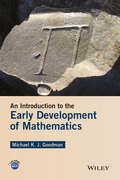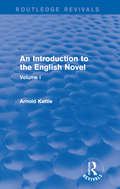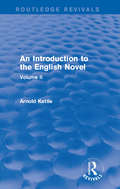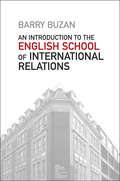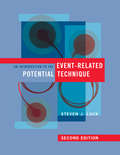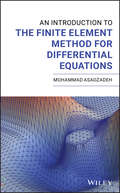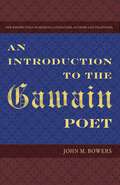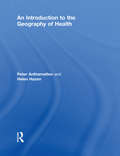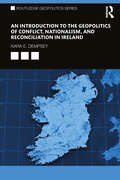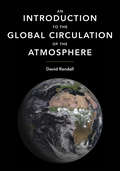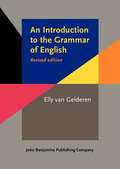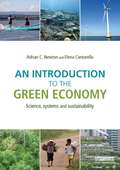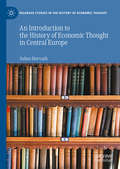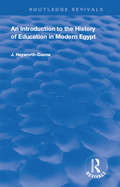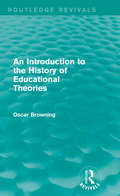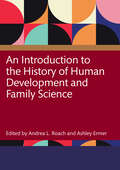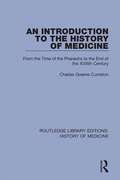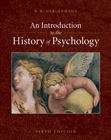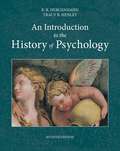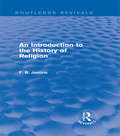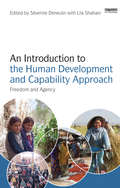- Table View
- List View
An Introduction to the Early Development of Mathematics
by Michael K. GoodmanAn easy-to-read presentation of the early history of mathematics Engaging and accessible, An Introduction to the Early Development of Mathematics provides a captivating introduction to the history of ancient mathematics in early civilizations for a nontechnical audience. Written with practical applications in a variety of areas, the book utilizes the historical context of mathematics as a pedagogical tool to assist readers working through mathematical and historical topics. The book is divided into sections on significant early civilizations including Egypt, Babylonia, China, Greece, India, and the Islamic world. Beginning each chapter with a general historical overview of the civilized area, the author highlights the civilization’s mathematical techniques, number representations, accomplishments, challenges, and contributions to the mathematical world. Thoroughly class-tested, An Introduction to the Early Development of Mathematics features: Challenging exercises that lead readers to a deeper understanding of mathematics Numerous relevant examples and problem sets with detailed explanations of the processes and solutions at the end of each chapter Additional references on specific topics and keywords from history, archeology, religion, culture, and mathematics Examples of practical applications with step-by-step explanations of the mathematical concepts and equations through the lens of early mathematical problems A companion website that includes additional exercises An Introduction to the Early Development of Mathematics is an ideal textbook for undergraduate courses on the history of mathematics and a supplement for elementary and secondary education majors. The book is also an appropriate reference for professional and trade audiences interested in the history of mathematics. Michael K. J. Goodman is Adjunct Mathematics Instructor at Westchester Community College, where he teaches courses in the history of mathematics, contemporary mathematics, and algebra. He is also the owner and operator of The Learning Miracle, LLC, which provides academic tutoring and test preparation for both college and high school students.
An Introduction to the Engineering of Fast Nuclear Reactors
by Anthony M. JuddThis book is an invaluable resource for both graduate-level engineering students and practicing nuclear engineers who want to expand their knowledge of fast nuclear reactors, the reactors of the future! The book is a concise yet comprehensive introduction to all aspects of fast reactor engineering. It covers topics including neutron physics; neutron flux spectra; flux distribution; Doppler and coolant temperature coefficients; the performance of ceramic and metal fuels under irradiation, structural changes, and fission-product migration; the effects of irradiation and corrosion on structural materials, irradiation swelling; heat transfer in the reactor core and its effect on core design; coolants including sodium and lead-bismuth alloy; coolant circuits; pumps; heat exchangers and steam generators; and plant control. The book includes new discussions on lead-alloy and gas coolants, metal fuel, the use of reactors to consume radioactive waste, and accelerator-driven subcritical systems.
An Introduction to the English Novel: Volume I (Routledge Revivals: An Introduction to the English Novel)
by Arnold KettleFirst published in 1951 (this edition in 1967), this book forms the first part of Arnold Kettle’s An Introduction to the English Novel. Since the novel, like every other literary form, is a product of history, the book opens with a discussion of how and why the novel developed in England in the eighteenth century, as well as the function and background of prose fiction. The third part of the book examines six great novels from Jane Austen to George Eliot. ‘A serious and rewarding study.’ The Times Literary Supplement ‘His examination of some eighteenth century writers and analysis of six famous novels- from Emma to Middlemarch- have wit, authority and a sensitivity that compel the reader’s attention.’ Dublin Magazine
An Introduction to the English Novel: Volume II (Routledge Revivals: An Introduction to the English Novel)
by Arnold KettleFirst published in 1953, this book forms the second part of Arnold Kettle’s An Introduction to the English Novel. In this second part, Kettle builds a discussion of the modern English novel around the study of various books that have a more than casual significance in its development. He begins with an analysis of James, Hardy and Butler: three late Victorian writers whose work points forward to the major preoccupations of twentieth-century novelists. In his discussion of a dozen or so of these points, the author examines their progress in the long struggle of the novelist to see life steadily and whole, and points out some of the problems and hazards that beset the writer still. ‘The selection both of novelists and their work is excellent… it is both shrewd and witty…’ The Times Literary Supplement ‘Altogether this is a refreshing, challenging and original work, wholly adult in tone, and never pedantic or dull’ The Guardian
An Introduction to the English School of International Relations: The Societal Approach
by Barry BuzanThis outstanding book is the first comprehensive introduction to the English School of International Relations. Written by leading ES scholar Barry Buzan, it expertly guides readers through the English School’s formative ideas, intellectual and historical roots, current controversies and future avenues of development. Part One sets out the English School’s origins and development, explaining its central concepts and methodological tools, and placing it within the broader canon of IR theory. Part Two offers a detailed account of the historical, regional and social structural strands of the English School, explaining the important link between the school’s historical projects and its interest in a societal approach to international relations. Part Three explores the School’s responses to the enduring problems of order and justice, and highlights the changing balance between pluralist and solidarist institutions in the evolution of international society over the past five centuries. The book concludes with a discussion of the English School’s ongoing controversies and debates, and identifies opportunities for further research. For students new to the topic this book will provide an accessible and balanced overview, whilst those already familiar with the ES will be prompted to look afresh at their own understanding of its significance and potentiality.
An Introduction to the Event-Related Potential Technique, second edition
by Steven J. LuckAn essential guide to designing, conducting, and analyzing event-related potential (ERP) experiments, completely updated for this edition.The event-related potential (ERP) technique, in which neural responses to specific events are extracted from the EEG, provides a powerful noninvasive tool for exploring the human brain. This volume describes practical methods for ERP research along with the underlying theoretical rationale. It offers researchers and students an essential guide to designing, conducting, and analyzing ERP experiments. This second edition has been completely updated, with additional material, new chapters, and more accessible explanations. Freely available supplementary material, including several online-only chapters, offer expanded or advanced treatment of selected topics.The first half of the book presents essential background information, describing the origins of ERPs, the nature of ERP components, and the design of ERP experiments. The second half of the book offers a detailed treatment of the main steps involved in conducting ERP experiments, covering such topics as recording the EEG, filtering the EEG and ERP waveforms, and quantifying amplitudes and latencies. Throughout, the emphasis is on rigorous experimental design and relatively simple analyses. New material in the second edition includes entire chapters devoted to components, artifacts, measuring amplitudes and latencies, and statistical analysis; updated coverage of recording technologies; concrete examples of experimental design; and many more figures. Online chapters cover such topics as overlap, localization, writing and reviewing ERP papers, and setting up and running an ERP lab.
An Introduction to the Finite Element Method for Differential Equations
by Mohammad AsadzadehMaster the finite element method with this masterful and practical volume An Introduction to the Finite Element Method (FEM) for Differential Equations provides readers with a practical and approachable examination of the use of the finite element method in mathematics. Author Mohammad Asadzadeh covers basic FEM theory, both in one-dimensional and higher dimensional cases. The book is filled with concrete strategies and useful methods to simplify its complex mathematical contents. Practically written and carefully detailed, An Introduction to the Finite Element Method covers topics including: An introduction to basic ordinary and partial differential equations The concept of fundamental solutions using Green's function approaches Polynomial approximations and interpolations, quadrature rules, and iterative numerical methods to solve linear systems of equations Higher-dimensional interpolation procedures Stability and convergence analysis of FEM for differential equations This book is ideal for upper-level undergraduate and graduate students in natural science and engineering. It belongs on the shelf of anyone seeking to improve their understanding of differential equations.
An Introduction to the French Poets: Villon to the Present Day (Routledge Revivals)
by Geoffrey BreretonThe French poetry of some five centuries is here surveyed in a series of studies of the work and personality of individual poets from Villon to the present day. Each chapter is primarily concerned with establishing the ‘literary identity’ of the poet or poets with whom it deals: the work of each is outlined and related to the historical and biographical circumstances in which it was written; and its characteristics are then examined critically in terms relevant to the modern reader. Comparisons are made between different poets, and more general topics – such as the concepts of ‘classic’ and ‘baroque’ – are discussed. This book, first published in 1956, had become a standard introductory work for students of French poetry and general readers alike. For this revised edition, originally published in 1973, new chapters have been added on ‘irregular’ seventeenth-century poets and on various modern poets whose work now enables the Surrealist movement to be seen in clearer perspective. The bibliography has been revised extensively.
An Introduction to the Gawain Poet (New Perspectives on Medieval Literature: Authors and Traditions)
by John M BowersIn An Introduction to the Gawain Poet, John Bowers surveys an expanded selection of the works of Chaucer's anonymous contemporary, considering Sir Gawain and the Green Knight alongside the poet's lesser known but no less brilliant works.In addition to his succinct introductions and plot summaries, Bowers skillfully details the cultural, historical, political, and religious contexts for these works, synthesizing them with close reading of selected passages. Perhaps his most exciting contribution to the field is his choice to historicize the poet's life and works in the context of the royal culture of King Richard II, boldly contending that it was highly possible the Gawain Poet was a frequent visitor to Richard's court in London. The final chapter surveys the works influenced by, as well as the influences reflected in, the poet's work, from the Bible to The Lord of the Rings. The attention Bowers pays to the critical tradition that has developed around these texts over the past hundred years makes An Introduction to the Gawain Poet an ideal volume for both undergraduate students and scholars of the Gawain Poet. Bowers has marshaled his formidable skills to create a book impressive in its balanced combination of breadth and depth.
An Introduction to the Geography of Health
by Peter Anthamatten Helen HazenHealth issues such as the emergence of infectious diseases, the potential influence of global warming on human health, and the escalating strain of increasing longevity and chronic conditions on healthcare systems are of growing importance in an increasingly peopled and interconnected world. A geographic approach to the study of health offers a critical perspective to these issues, considering how changing relationships between people and their environments influence human health. An Introduction to the Geography of Health provides an accessible introduction to this rapidly growing field, covering theoretical and methodological background. The text is divided into three sections which consider distinct approaches and techniques related to health geographies. Section one introduces ecological approaches, with a focus on how natural and built environments affect human health. For instance, how have irrigation projects influenced the spread of water-borne diseases? How can modern healthcare settings, such as hospitals, affect the spread and evolution of pathogens? Section two discusses social aspects of health and healthcare, considering health as not merely a biological interaction between a pathogen and human host, but as a process that is situated among social factors which ultimately drive who suffers from what, and where disease occurs. Section three then considers spatial techniques and approaches to exploring health, giving special focus to the growing role of cartography and geographic information systems (GIS) in the study of health. This clearly written text contains a range of pedagogical features including a wealth of global case studies, discussion questions and suggestions for further reading at the end of each chapter, a colour plate section and over eighty diagrams and figures. The accompanying website also provides presentations, exercises, further resources, and tables and figures. This book is an essential introductory text for undergraduate students studying Geography, Health and Social Studies.
An Introduction to the Geography of Health
by Peter Anthamatten Helen HazenIn the second edition of An Introduction to the Geography of Health, Hazen and Anthamatten explore the ways in which geographic ideas and approaches can inform our understanding of health. The book’s focus on a broad range of physical and social factors that drive health in places and spaces offers students and scholars an important holistic perspective on the study of health in the modern era. In this edition, the authors have restructured the book to emphasize the theoretical significance of ecological and social approaches to health. Spatial methods are now reinforced throughout the book and other qualitative and quantitative methods are discussed in greater depth. Data and examples are used extensively to illustrate key points and have been updated throughout, including several new extended case studies such as water contamination in Flint Michigan, microplastics pollution, West Africa’s Ebola crisis, and the Zika epidemic. The book contains over one hundred figures, including new and updated maps, data graphics, and photos. The book is designed to be used as the core text for a health geography course for undergraduate and lower-level graduate students, and is relevant to students of biology, medicine, entomology, social science, urban planning, and public health.
An Introduction to the Geopolitics of Conflict, Nationalism, and Reconciliation in Ireland (Routledge Geopolitics Series)
by Kara E. DempseyThis book examines ethnoterritorial conflict and reconciliation in Ireland from the 1916 Rising to Brexit (2021), including the production and consequences of the island’s two distinct political units. Highlighting key geographic themes of bordering, unity, division, and national narratives, it explores how geopolitical space has been employed over time to (re)define divided national allegiances throughout Ireland and within Irish–British relations. The analysis draws from in-depth interviews and archival research, and spans supranational, state, municipal, neighborhood, and individual scales. The book pays particular attention to uneven power structures, statecraft, perceived truths, lived experiences, reconciliation efforts, and renegotiations of national narratives in the production of symbolic landscapes, divided cities, and "shared" space. An Introduction to the Geopolitics of Conflict, Nationalism, and Reconciliation in Ireland provides readers with an analysis of geopolitical power relations and different spatial productions of conflict and peacebuilding in Ireland. Offering deeper understanding of these historic and contemporary geopolitical intersections, this book makes a valuable contribution to the fields of Political Geography, Border Studies, Irish Studies, European Studies, International Relations, Cultural Geography, and Regional Studies.
An Introduction to the Global Circulation of the Atmosphere
by David RandallThis is a graduate-level textbook on the global circulation of the Earth's atmosphere--the large-scale system of winds by which energy is transported around the planet, from the tropical latitudes to the poles. Written by David Randall, one of the world's foremost experts on the subject, it is the most comprehensive textbook on the topic. Intended for Earth science students who have completed some graduate-level coursework in atmospheric dynamics, the book will help students build on that foundation, preparing them for research in the field.The book describes the many phenomena of the circulation and explains them in terms of current ideas from fluid dynamics and thermodynamics, with frequent use of isentropic coordinates and using the methods of vector calculus. It emphasizes the key roles of water vapor and clouds, includes detailed coverage of energy flows and transformations, and pays close attention to scale interactions. The book also describes the major historical contributions of key scientists, giving a human dimension to the narrative, and it closes with a discussion of how the global circulation is evolving as the Earth's climate changes.The most comprehensive graduate-level textbook on the subjectWritten by one of the world's leading expertsConnects global circulation and climate phenomenaAddresses energy, moisture, and angular-momentum balance; the hydrologic cycle; and atmospheric turbulence and convectionEmphasizes the energy cycle of the atmosphere; the role of moist processes; and circulation as an unpredictable, chaotic processHelps prepare students for researchAn online illustration package is available to professors
An Introduction to the Grammar of English
by Elly Van GelderenIt has been eight years since An Introduction to the Grammar of English was first published. The second edition is completely revised and greatly expanded, especially where texts, example sentences, exercises, and cartoons are concerned. It continues to provide a very lively and clearly written textbook. The book introduces basic concepts of grammar in a format which inspires the reader to use linguistic arguments. The style of the book is engaging and examples from poetry, jokes, and puns illustrate grammatical concepts. The focus is on syntactic analysis and evidence. However, special topic sections contribute sociolinguistic and historical reasons behind prescriptive rules such as the bans on split infinitives, dangling participles, and preposition stranding. The book is written for undergraduate students and structured for a semester-long course. It provides exercises, keys to those exercises, and sample exams. It also includes a comprehensive glossary.
An Introduction to the Green Economy: Science, Systems and Sustainability
by Adrian C. Newton Elena CantarelloThe green economy is widely seen as a potential solution to current global economic and environmental crises, and a potential mechanism by which sustainable development might be achieved in practice. Considerable investments are now being made into the development of green technology, renewable energy, biodiversity conservation, resource efficiency, recycling of materials and green infrastructure. This textbook provides a comprehensive introduction to the green economy, using a strongly interdisciplinary approach based on environmental science, rather than treating it as a sub-set of economics. The scientific principles of sustainability are presented, which provide the foundations of the green economy, with a particular focus on systems-based approaches. Examples of real-world case studies are used to illustrate how the green economy can be achieved in practice. In this way, the authors provide a thorough overview of both the principles and practice of the green economy, drawing from a wide range of disciplines including ecology, geography, social science, psychology, sustainability science, environmental science, law and economics. The emphasis is on presenting results of the latest research, derived from leading scientific journals. Rather than focusing on a single definition of what constitutes a ‘green economy’, the book introduces readers to the diversity of opinion that exists, and engages them in what is an active, on-going debate. This reflects the fact that many aspects of the green economy, and sustainable development more generally, are currently contested. In particular, the book will help readers to strengthen their ability to critically evaluate the evidence for and against the views presented, and to actively contribute to the future development of the green economy.
An Introduction to the History of Economic Thought in Central Europe (Palgrave Studies in the History of Economic Thought)
by Julius HorvathThis book addresses the comparative history of economic thought in Central European countries where there is a notable common historic heritage and political traits. The author explores issues of Central European identity, Habsburgian and Soviet influence, and nationalistic traditions, and reveals commonalities between Czech, Hungarian, Polish and Slovak economic thought: such similarities proceed to explain aspects of contemporary economic and social policies in these countries.This book aims to highlight connections among Central European economists and will be of interest to economists, economic historians, sociologists and historians.
An Introduction to the History of Education in Modern Egpyt (Routledge Revivals)
by J. Heyworth-DunneFirst published in 1968, An Introduction to the History of Education in Modern Egypt collects all available sources, Eastern and Western, printed and manuscript, in order to give as full an account as possible of all the education reforms undertaken in Egypt. It covers topics including the penetration of Western culture in Egypt, Abbas 1, Muhammad Sa’id and The Reign of Isma’il Pasha.
An Introduction to the History of Educational Theories (Routledge Revivals)
by Oscar BrowningAn Introduction to the History of Educational Theories, first published in 1881, offers a comprehensive overview of the most notable approaches to education throughout Western history, from Athens and Rome to the Victorian public school. Exploring not only the still famous theories of Plato and Aristotle, this work also touches on techniques in education which are either no longer prevalent – Roman Oratory, the Jesuits – or in some cases were never widely adopted or appreciated: John Milton, for example. This title will be of value to those intrigued by the potential of past attitudes for present-day application, as well as to those unconvinced by contemporary approaches.
An Introduction to the History of Human Development and Family Science
by Andrea L. RoachThis comprehensive textbook offers an interdisciplinary introduction to the history of human development and family science. It provides insights from home economics, sociology and psychology to explain and analyze how the field was established and how it is developing and showcases the contribution of its unique transdisciplinary nature.Expert authors cover key topics and highlight historical contributions from women, scholars of color and LGBTQIA scholars; they emphasize and incorporate research that cuts across cultures; and examine current human development and family science trends in research and careers in their chosen fields. Subjects and issues covered include historical and contemporary studies of child development, adolescent development and young adulthood, adulthood and aging, family science, marriage formation and maintenance, parenthood, divorce, the role of grandparents and sibling relationships.Exploring how human development and family science can be used as a springboard into careers such as marriage and family therapy, social work, case management, teaching and research, this essential textbook is for all students of human development and family science.
An Introduction to the History of Medicine: From the Time of the Pharaohs to the End of the XVIIIth Century (Routledge Library Editions: History of Medicine #3)
by Charles Greene CumstonOriginally published in 1926, An Introduction to the History of Medicine is a compilation of reliable and essential contributions to the subject of the history of medicine. The book looks at the evolution of medicine from the practices in Ancient Egypt, to the medicine of the 16th century, and examines the work of Hippocrates and Galen. The book also examines the philosophy that began around the practice of medicine, as well as early discussions of ethics. It also looks at early medicine through the lens of religion, covering the practices of medicine in Hindu, Chaldean and Islamic religions. The book provides a broad coverage of early medicine in ancient civilizations, focusing particularly on Ancient Greece, Persia and Rome.
An Introduction to the History of Psychology
by B. R. HergenhahnThis textbook traces the history of psychology from the ancient Greeks to the present, with chapters discussing the major schools of thought, important developments, and the contributions of particular theorists. Among those discussed are Aristotle, empiricism and positivism, rationalism, romanticism and existentialism, the rise of experimental psychology, the rise of mental testing, functionalism, behaviorism, Gestalt psychology, psychoanalysis, humanistic psychology, psychobiology, and cognitive psychology. Hergenhahn taught at Hamline University. Annotation ©2004 Book News, Inc., Portland, OR (booknews.com)
An Introduction to the History of Psychology
by B. R. Hergenhahn Tracy HenleyDreams puzzled early man, Greek philosophers spun elaborate theories to explain human memory and perception, Descartes postulated that the brain was filled with "animal spirits," and psychology was officially deemed a "science" in the 19th century. In this Seventh Edition of AN INTRODUCTION TO THE HISTORY OF PSYCHOLOGY, authors Hergenhahn and Henley demonstrate that most of the concerns of contemporary psychologists are manifestations of themes that have been part of psychology for hundreds--or even thousands--of years. The book's numerous photographs and pedagogical devices, along with its biographical material on key figures in psychology, engage readers and facilitate their understanding of each chapter. Available with InfoTrac Student Collections http://gocengage. com/infotrac.
An Introduction to the History of Religion (Routledge Revivals)
by F. B. JevonsFirst published in 1902, this book investigates the history and development of early religion from an anthropological perspective. Rather than dealing with religions that grew from the teachings of their original founders, such as Christianity, Islam, and Buddhism, Jevons considers those religions that were practised as a matter of custom and tradition. The title considers such subjects as the supernatural, life and death, animal sacrifice, and the worship of nature. It provides an introduction to the history of religion for students of religion, anthropology and folklore.
An Introduction to the Human Development and Capability Approach: Freedom and Agency
by Severine DeneulinAimed at undergraduates and post-graduates in the social sciences, as well as development practitioners, this textbook provides an introduction to the human development and capability approach; it also clarifies key concepts and fosters debate on a number of critical issues. The book offers new perspectives on a wide range of topics, which include the conceptualisation and measurement of well-being and inequality; the role of markets and economic growth in promoting development; the importance of democracy and public debate; culture and religion; health; equality and justice; and the connections between social and economic policy in addressing poverty and inequality. Case studies from across the world are used to illustrate concepts and highlight the relevance of the approach in addressing contemporary development challenges. A set of questions accompanies each chapter for seminar discussion to help readers assimilate central points and apply the approach to diverse realities. This book provides a comprehensive introduction to the human development and capability approach for students and practitioners world-wide.
An Introduction to the International Criminal Court
by Schabas William A. OC MRIAThe International Criminal Court has ushered in a new era in the protection of human rights. Protecting against genocide, crimes against humanity and war crimes, the Court acts when national justice systems are unwilling or unable to do so. This third edition of this seminal text on the Court considers it in action: its initial rulings by the Pre-Trial Chambers and the Appeals Chamber and those cases it is prosecuting as well as those where it had decided not to proceed, such as Iraq. It also explores the law of the Court up to and including its ruling on a confirmation hearing. It addresses the political context of the court, such as the difficulties created by US opposition and the increasing recognition of the inevitability of the institution. Written by the leading expert in the field, this text is essential reading for any student of the Court and its workings.
